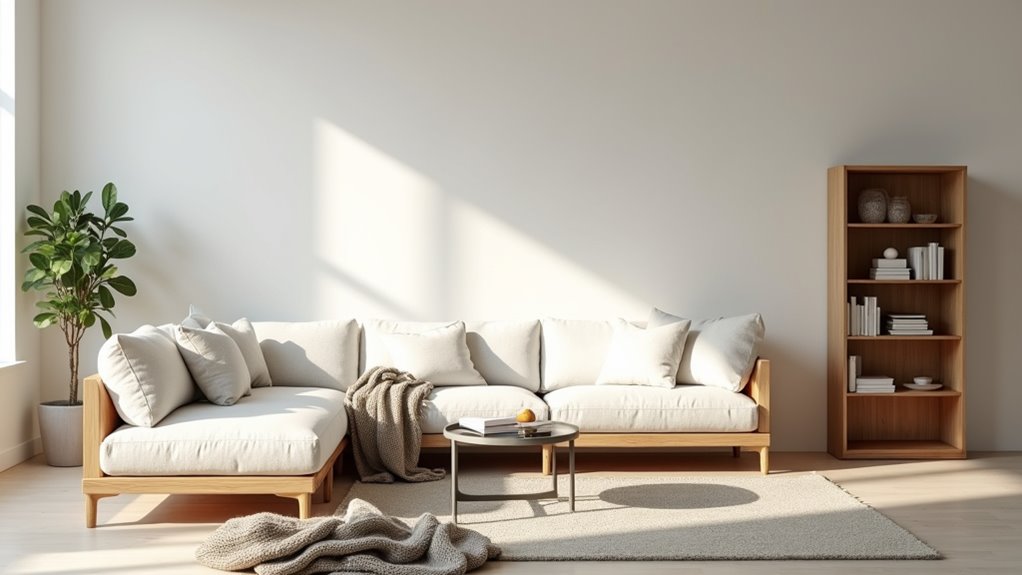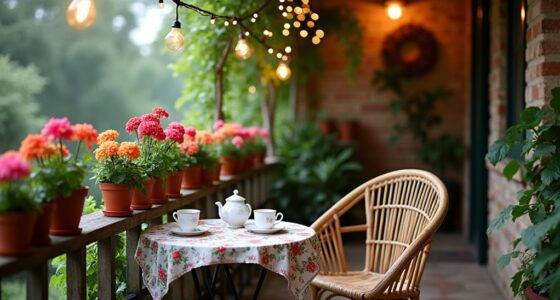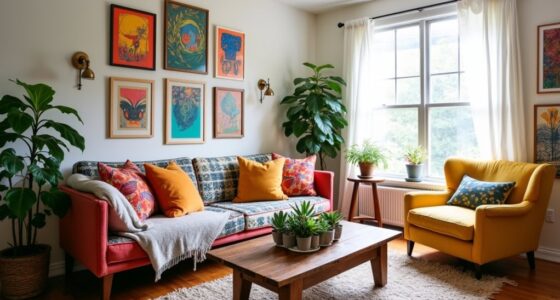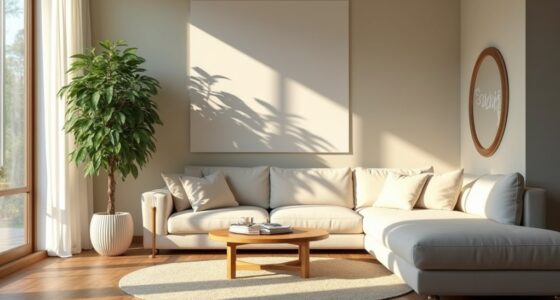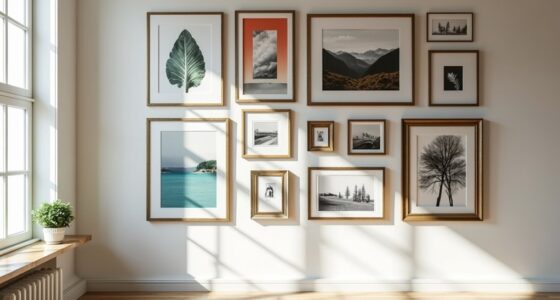Scandinavian design principles for a minimalist home focus on simplicity and functionality. You’ll want to declutter your space, keeping only items that serve a purpose. Use a neutral color palette to promote tranquility and enhance natural light with large windows and mirrors. Incorporate functional furniture with clean lines and natural materials, creating a cozy yet serene atmosphere. There’s so much more to explore about achieving this aesthetic in your own home.
Key Takeaways
- Emphasize simplicity by selecting functional furniture that serves multiple purposes and eliminates unnecessary items.
- Utilize a neutral color palette to create a tranquil and open atmosphere in your home.
- Maximize natural light by incorporating large windows and mirrors to enhance brightness in living spaces.
- Focus on using natural materials like wood and wool to add warmth and comfort to your minimalist design.
- Declutter regularly to maintain a serene environment, allowing essential items to shine and promote mindfulness.
What Is Scandinavian Minimalism?

When you think of Scandinavian minimalism, it’s all about simplicity and functionality. This design philosophy emphasizes reducing the unnecessary to focus on what’s essential, creating inviting spaces that withstand harsh climates.
By prioritizing natural materials, you’ll notice a warmth that contrasts with the coldness of minimalism elsewhere. Functional design plays an essential role, ensuring that every piece serves a purpose while still being aesthetically pleasing. Incorporating vertical storage solutions can further enhance the efficiency of your living space, allowing for a more organized environment. Embracing sustainable habits not only aligns with Scandinavian values but also supports overall well-being. To create a more inviting atmosphere, consider using cozy textiles that add comfort and warmth to your minimalist space.
The use of subtle pastel tones and meticulous space optimization fosters a sense of calm and connection to nature. Scandinavian minimalism reflects cultural values of happiness and sustainability, encouraging you to reflect on quality craftsmanship over quantity. Additionally, incorporating sustainable living practices can further enhance the harmony of your minimalist environment.
Subtle pastel tones and thoughtful space design cultivate tranquility and a deep connection to nature in Scandinavian minimalism.
Ultimately, it’s about creating a mindful, harmonious environment that enhances your well-being.
The History of Scandinavian Minimalism

Scandinavian minimalism has roots in the rich cultural heritage of the Nordic region, where simplicity and functionality reign supreme. Influential figures like Alvar Aalto and Arne Jacobsen shaped its early development, setting the stage for a movement that would evolve through the decades. As you explore its history, you’ll see how each country brought its unique touch to the minimalist aesthetic we recognize today. This design philosophy reflects the elegance of simplicity, emphasizing that less truly can be more. Additionally, the principles of astrological compatibility can inspire a sense of harmony in creating a serene living environment that aligns with personal values. The emphasis on functional design has played a crucial role in promoting a lifestyle that values practicality alongside beauty. Furthermore, a strong focus on natural materials enhances the connection between the design and the surrounding environment, creating spaces that feel grounded and authentic.
Origins in Nordic Culture
Emerging in the 1930s, minimalism in Nordic design reflects the region’s rich cultural heritage and practical needs. Influenced by the Bauhaus principles of simplicity and functionality, Scandinavian minimalist interior design emphasizes clean lines and natural materials like wood. As you explore this style, you’ll appreciate how cultural characteristics, including long winters and the concept of lagom, shape an emphasis on balance, sustainability, and comfort. The movement gained momentum in the 1950s, with brands like IKEA promoting versatile, space-optimizing designs. Each Scandinavian country—Denmark, Sweden, and Norway—shows unique stylistic variations while adhering to core design principles. This philosophy values well-crafted, timeless pieces, encouraging mindful consumption and reducing waste in your home. Additionally, these design elements often incorporate natural materials that enhance the serene atmosphere characteristic of Scandinavian homes. Furthermore, the focus on sustainable building practices aligns with the growing trend of eco-friendly living, which is essential in today’s world. Decluttering spaces not only complements minimalist aesthetics but also contributes to emotional well-being, creating a peaceful environment that reflects Scandinavian values. Moreover, embracing estate planning can provide a sense of security that aligns with the Scandinavian ethos of thoughtful living.
Influential Design Figures
While the principles of Scandinavian minimalism took shape in the 1930s, it was the vision of key figures like Alvar Aalto and Arne Jacobsen that truly defined the movement.
These influential figures drew from the Bauhaus School, emphasizing functionality and simplicity. Scandinavian design embraces a minimalist approach, focusing on quality craftsmanship and the use of natural elements, similar to the incorporation of natural materials found in farmhouse decor. This dedication to craftsmanship is essential for creating a supportive environment that enhances elderly care at home. In addition, the use of freshly squeezed juices can contribute to a healthier lifestyle that aligns with minimalist principles.
In the 1950s, designers like Hans Wegner further popularized this aesthetic with iconic chair designs that seamlessly blend beauty and practicality.
Norwegian designer Øyvind Wyller has also made a mark, innovating within traditional minimalist tenets while exploring contemporary boundaries.
Together, these designers have shaped a cultural emphasis on balance and sustainability, keeping the essence of Scandinavian minimalism alive. This focus on sustainable building materials is also evident in modern tiny house designs, reflecting a broader trend towards eco-friendly living.
Evolution Through Decades
As the 1930s unfolded, the principles of Scandinavian minimalism began to crystallize, shaped by the innovative ideas of designers who prioritized functionality and simplicity. Influenced by the Bauhaus School, figures like Alvar Aalto and Arne Jacobsen emphasized natural materials and essential elements in their minimalist designs. The movement gained momentum in the 1950s, with brands like IKEA popularizing versatile, space-saving furniture that showcased timeless appeal and best lifestyle products designed for everyday use. Each Scandinavian country brought its unique flavor, from Denmark’s urban efficiency to Sweden’s concept of lagom, promoting balance. Furthermore, the beauty industry has seen a rise in clean beauty products, reflecting a similar commitment to sustainability and mindful consumption. This focus on ethical design principles has become a hallmark of the Scandinavian approach, ensuring that functionality harmonizes with environmental consciousness.
Today, modern brands like Axel Arigato and Acne Studios continue this evolution, merging high-quality craftsmanship with minimalist aesthetics. This journey reflects a commitment to sustainability and mindful consumption through well-crafted, functional designs. Furthermore, the integration of eco-friendly power solutions has become increasingly important in contemporary Scandinavian homes, emphasizing a holistic approach to minimalism.
The Pillars of Scandinavian Minimalism

When you think about Scandinavian minimalism, consider how purposeful design elements play an essential role in creating functional spaces. The use of natural materials enhances this aesthetic, fostering a strong connection to nature while ensuring harmony throughout your home. Additionally, embracing sustainable practices aligns with the growing consumer demand for ethical sourcing and environmental responsibility. Incorporating solar energy solutions into your home design not only supports sustainability but also reduces energy costs and enhances your living environment.
Purposeful Design Elements
Purposeful design elements lie at the heart of Scandinavian minimalism, ensuring that every piece in your space not only looks good but also serves a specific function.
Functionality is key; each item contributes to the overall utility without unnecessary decoration. You’ll appreciate the simplicity of clean lines and neutral color palettes that create a serene atmosphere, fostering calm and clarity.
Mindful consumption encourages you to reflect on quality over quantity, promoting sustainable practices in your home. By choosing natural materials, you create a peaceful environment that connects your indoor space with the outdoors.
All these elements come together for harmonious living, enhancing your well-being and promoting a sense of order in your minimalist sanctuary.
Natural Material Emphasis
Natural materials play a pivotal role in Scandinavian design, reinforcing the connection to nature while enhancing the warmth of your interior spaces.
By incorporating elements like wood, stone, and textiles, you create a cozy atmosphere that embraces the principles of hygge.
Here’s how you can emphasize natural materials in your home:
- Choose solid wood furniture, such as oak, for durability and timeless beauty.
- Use wool textiles, like throws and rugs, to add warmth and texture.
- Incorporate indoor plants to improve air quality and bring life to your minimalist design.
These natural materials not only enrich your space but also reflect a commitment to sustainability, making your home feel inviting and grounded in the serene essence of Scandinavian style.
Balanced Aesthetic Harmony
Balanced aesthetic harmony lies at the heart of Scandinavian minimalism, where every design choice contributes to a serene and inviting environment. By focusing on functionality, you guarantee each item serves a purpose, marrying beauty with practicality. A neutral color palette and clean lines create a tranquil space, while natural materials like wood and stone enhance your connection to nature. Mindful consumption fosters a balanced home, encouraging you to reflect on each addition carefully.
| Design Element | Key Feature | Impact on Space |
|---|---|---|
| Functionality | Purpose-driven design | Reduces clutter |
| Neutral Color | Soft, calming hues | Promotes tranquility |
| Clean Lines | Simple silhouettes | Enhances spaciousness |
| Natural Materials | Organic textures | Connects to nature |
How to Create Your Scandinavian-Inspired Home

Creating a Scandinavian-inspired home starts with decluttering your space to foster a serene atmosphere. Remove items that lack purpose or joy, embracing the minimalist lifestyle.
Next, choose a neutral color palette with whites, grays, and soft earth tones to enhance tranquility and openness.
Incorporate natural materials like wood and stone to connect with nature, while selecting functional furniture that boasts clean lines and serves multiple purposes, such as:
- Storage ottomans
- Convertible sofas
- Multi-use tables
Maximize natural light to make your space feel airy and bright.
Tips for Embracing Hygge in Design
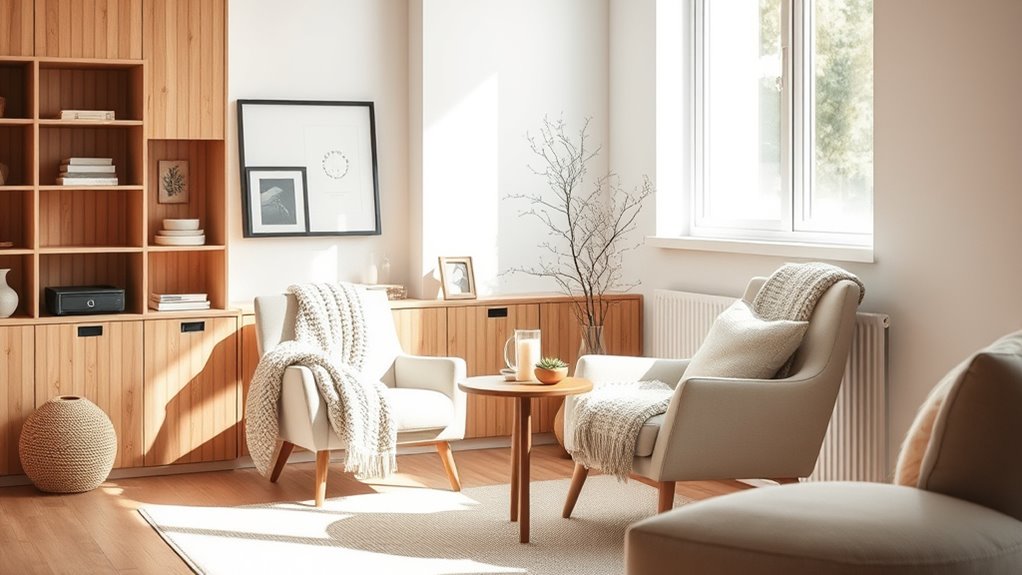
Embracing hygge in your design enhances the cozy, inviting atmosphere of your Scandinavian-inspired home.
Start by incorporating soft textiles like woolen throws and plush cushions; they encourage relaxation and warmth. Use warm, ambient light from lamps and candles to create a tranquil vibe.
Incorporate soft textiles and warm lighting to create a relaxing and tranquil atmosphere in your home.
Design intimate seating areas that foster conversation, making social interaction a priority. Incorporate natural wood furniture and indoor plants to improve air quality and connect with nature, essential aspects of hygge.
Finally, declutter your space to maintain simplicity and order, evoking calmness and mindful living.
Key Elements of Scandinavian Minimalist Aesthetics
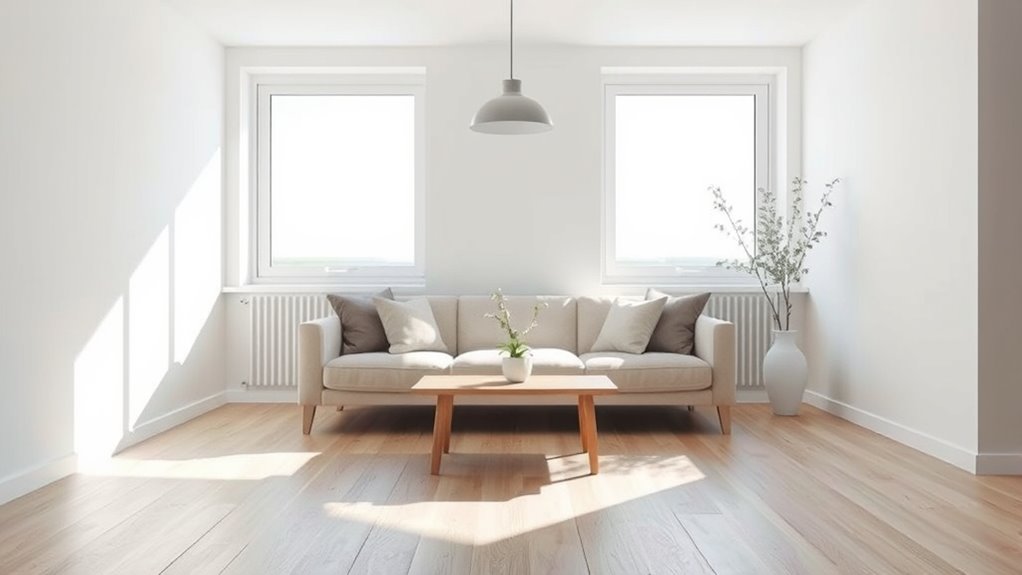
Scandinavian minimalist aesthetics focus on simplicity and functionality, ensuring that every item in your space serves a purpose. This approach creates an uncluttered environment that promotes well-being and relaxation.
Key elements include:
- Functionality: Every piece should be practical and contribute to the overall design.
- Color Scheme: Neutral tones like whites, grays, and soft earth tones foster a calm atmosphere.
- Light: Maximize natural light with large windows and mirrors, brightening your interiors.
Additionally, incorporating natural materials like wood and stone adds warmth to your home.
The pared-back aesthetic emphasizes comfort and simplicity, allowing you to enjoy a serene space that reflects the essence of Scandinavian design.
Embrace these elements to create a harmonious and inviting environment.
The Role of Natural Materials in Scandinavian Design

Natural materials play a pivotal role in shaping the essence of Scandinavian design, bringing a sense of warmth and connection to the outdoors. You’ll notice that light woods like birch and pine create inviting spaces, maximizing natural light. Natural stone elements offer both texture and durability, reinforcing the design’s focus on functionality. Textiles from wool and linen provide comfort while enhancing the cozy hygge atmosphere. Plus, incorporating indoor plants adds a touch of greenery, improving air quality and fostering tranquility.
| Material Type | Benefits |
|---|---|
| Wood | Warmth, natural light |
| Stone | Texture, durability |
| Textiles | Comfort, coziness |
| Indoor Plants | Air quality, tranquility |
Embrace these elements for a truly Scandinavian experience.
Carl Friedrik and the Essence of Minimalism
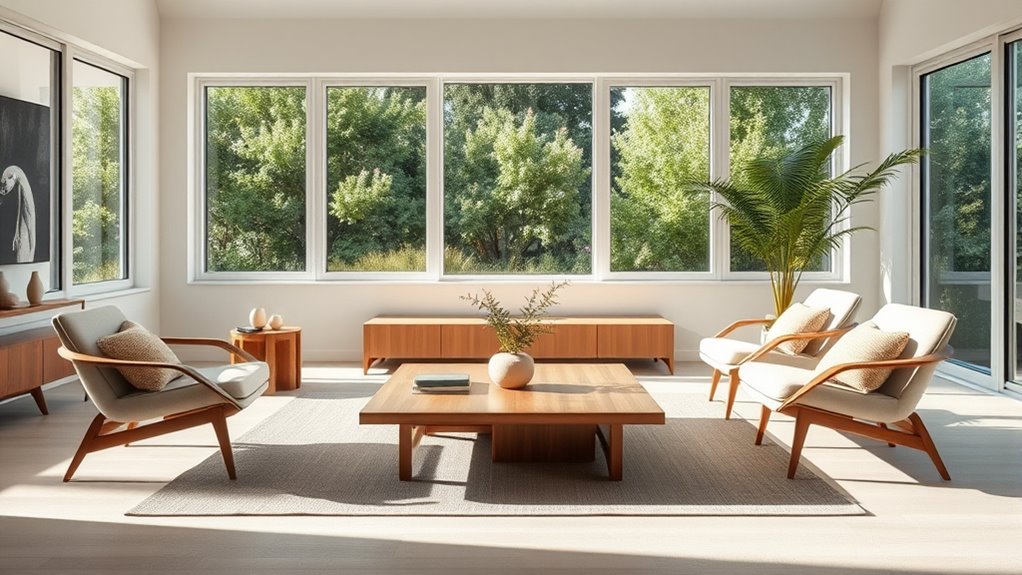
Minimalism thrives in the world of Carl Friedrik, where fine materials and artisanal craftsmanship converge to create products that embody both simplicity and functionality.
Every piece of furniture and accessory reflects key principles of Scandinavian design, ensuring they serve a purpose in your living spaces.
- The Palissy Briefcase merges elegance with practicality.
- The Leather Desk Mat enhances your workspace with minimal clutter.
- A lifetime warranty underscores durability, promoting sustainability over fast consumption.
Frequently Asked Questions
What Is Scandinavian Minimalist Design?
Scandinavian minimalist design focuses on simplicity and functionality, creating spaces that feel open and inviting.
You’ll notice a blend of natural materials like wood and stone, paired with a neutral color palette that fosters calm. This style emphasizes well-made, timeless furniture that serves a purpose, promoting a sense of balance.
Large windows let in natural light, making your home feel airy, while cozy textiles encourage relaxation and intimacy in your living environment.
What Are the Principles of Scandinavian Design?
Scandinavian design principles focus on simplicity, functionality, and a connection to nature.
You’ll appreciate how every piece of furniture serves a purpose while keeping your space uncluttered. Emphasizing natural materials like wood and stone brings warmth, while maximizing natural light brightens your interiors.
Incorporating the concept of hygge adds coziness, inviting relaxation.
Ultimately, prioritizing timelessness guarantees your design remains stylish and functional for years to come, evolving beautifully with your lifestyle.
What Are the Colors for Scandinavian Minimalist?
When you think about colors for a Scandinavian minimalist aesthetic, stick to whites, grays, and earthy tones.
These shades create a serene vibe. You might consider soft pastels as accents to add warmth without cluttering the space. Neutrals like beige can enhance the feeling of openness.
Don’t forget dark accents to provide contrast and interest.
Finally, incorporating natural colors inspired by Nordic landscapes, like muted greens and browns, helps you connect with nature.
How Do I Make My House Look Scandinavian?
To make your house look Scandinavian, think of creating a serene oasis that feels like a refreshing change.
Start with a neutral color palette—whites, grays, and earthy tones. Choose functional furniture with clean lines to optimize space. Incorporate natural materials like wood and textiles to add warmth.
Maximize natural light with big windows and light walls, while decluttering to keep only timeless, high-quality pieces that enhance simplicity.
Conclusion
Embracing Scandinavian design principles can transform your home into a serene sanctuary. By focusing on simplicity, functionality, and natural materials, you’ll create a space that feels both inviting and calming. Isn’t it time to let go of clutter and embrace a more minimalist lifestyle? With a few thoughtful changes, you can capture the essence of Scandinavian minimalism and enjoy its timeless beauty. So, why not start your journey toward a more peaceful home today?
